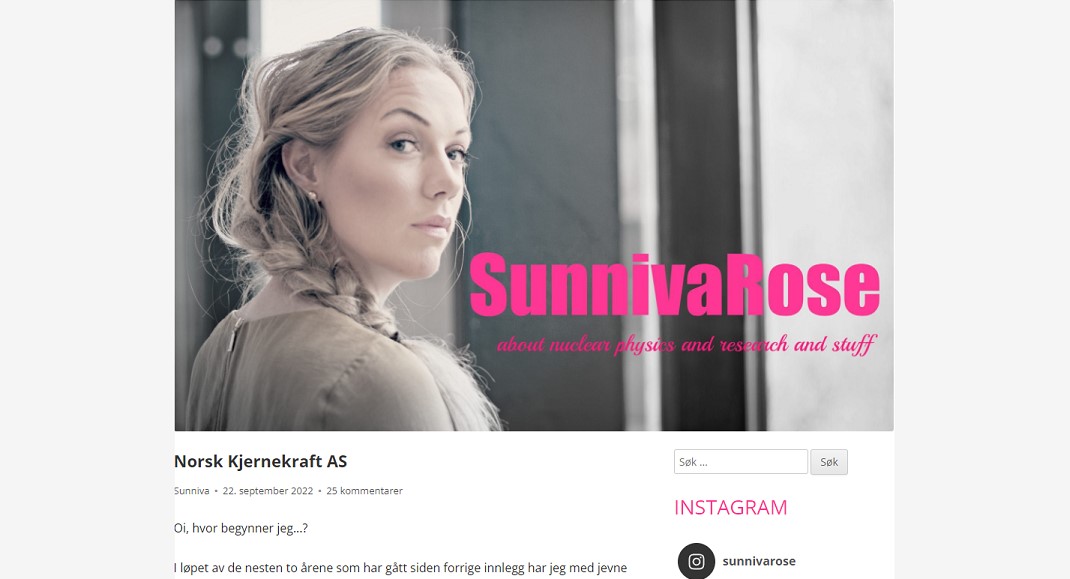Norwegian nuclear physicist: make space for pink in science
Sunniva Johanne Rose is a physicist and blogger. She is good at sciences but also loves shoes, makeup, interior design and fashion. During her academic career, she has faced much prejudice against women in pink.
As a child, she dreamt about a life in ballerina shoes and a pink tutu. She loved dancing and she loved the colour pink. Rose wanted to be a ballerina.
When she got a bit older, she got close to fulfilling her dream but then the scientist in her awoke. Because Rose also loved sciences – mathematics and physics. Could this be an alternative professional route?
She finally settled on sciences but carried on dancing as a hobby. She still loved pink, nice clothes, high-heeled shoes and makeup. Rose was a pink “babe”.
Academic journey
Physicist and blogger Sunniva Rose was one of the women who talked about their academic journey during “Girls and technology – inspiration day 2023” organised by OsloMet, The University of Oslo and NHO – the Confederation of Norwegian Enterprise.
Similar events were held at many Norwegian universities and higher educational institutions on 15 February this year.

Veronica Killi and Mathilde Ingeborg Nilsen Verne showed why it is important to have some fun while studying and at work. They served up an action-packed chemistry show.
"Jenter og teknologi" (Girls and technology) is a national recruitment project aiming to increase the number of women who choose to study science and technology. The project is run by NHO.
Norway still has a gender-segregated labour market, and young people still choose educations and careers typical for their gender. This is particularly evident in vocational and apprenticeship training.
At the same time, there is a serious skills shortage, especially in technology. Nearly half of the companies in NHO’s latest skills barometer say they lack sufficient ICT competence.
Dealing with prejudice
Rose told the event in Oslo that for many years she experienced that it was not OK to be “pink” and that she felt ostracised because she spent time and effort on what many around her considered to be “superficial things”.
When she started to struggle a bit academically at university, she began to doubt herself:
“Perhaps they are right? Perhaps I am actually a little bit stupid?”
She began to wonder whether she was actually fit to study science and whether there perhaps was not space for people like her who arrived to lectures and reading rooms in high heels with a handbag full of pink lip gloss while teaching dance in her spare time.
She explained how she, during a lecture, pointed out that the lecturer had made a mistake and a fellow student shouted: “But Sunniva, you are not stupid after all!”
She has also heard comments like “There are no blonde nuclear physicists”.
Got her PhD.
But Rose got a top-grade master’s degree. She secured a position as a PhD student, and today she works as a nuclear physicist with a PhD. in how to use Thorium as nuclear fuel.
She is head of communication at Norsk Kjernekraft AS (Norwegian Nuclear Power), a company that wants to build and run nuclear power plants in Norway. When there is a debate about nuclear power, Rose is often visible in the media.
She promotes nuclear power as an environmentally sound energy solution.
Pink blog
Rose created a pink blog “about nuclear physics and research and stuff”. She wanted to be Rose and not “only” a researcher. For her, that means mixing in some pink, makeup, and accessories with the scientific subject matter.
“It is important for me to underline that you can of course be both interested in and good at science while also loving shoes, makeup, interior design and fashion,” says Rose.

Sunniva Johanne Rose has her own blog. "If you want to help save the world, sciences is the way to go," is one of her messages.
Using her blog and inspirational speaking she wants to show girls that even if they like pink, they can be whatever they want to be regardless of what their dreams are.
Diversity is important
Rose believes science should be more, well, pink. The colour itself is not the point here, but diversity. Why? Well, because technology which is developed by a homogenous group of people will probably work best for that group. If technology is developed and tested by one group of people, it can quickly present problems for other groups.
“Most of the things we have were developed by men,” points out Rose and provides some examples of the resulting challenges. Women are 47 per cent more likely to be severely injured or to die in a car crash because testing to minimise car crash injuries has been done on crash test dummies that are based on the average male – more than 175 cm tall and weighing 80 kilos.
“The people who developed the airbag didn’t do this on purpose of course, but this example shows that it can be difficult to see the whole picture. This also goes for us women, of course. That is why it is important that both women and men do research,” argues Rose.
More girls chose sciences
“Girls and technology” was founded in 2003 by NHO. Three years later, in 2016, it grew into a national project. Today it gets state funding.
Higher education application figures show that more girls now choose science and technology subjects and that we are on the right course, explains Monica Aasen, national project leader for “Girls and technology”.

“The project has created more awareness around the gender-segregated labour market and knowledge about the need for diversity within technology. We have also helped increase application numbers and make the path to technology more visible for more people – for instance for young people who do not have parents who are engineers or any family working in IT,” says Aasen.
The project is still growing. This year it is touring the whole of Norway and will include company visits for thousands of girls. More inspiration days are planned and the project is active on social media like TikTok.
“We need all kinds of people to develop all kinds of technology that works in the best possible way for everyone. Diversity is not a fancy word, it is a necessity,” says Aasen.
- A bit more pink
-
-
"Even if you love pink, you can be good at sciences," said physicist and blogger Sunniva Johanne Rose when she addressed several hundreds of young girls who took part in "Girls and technology 2023" at Chateau Neuf in Oslo on 15 February.
-
- Jenter og teknologi (Girls and technology)
-
is a national recruitment project aiming to get more girls to study science and technology.
The project is run by NHO in cooperation with, among others, NITO (The Norwegian Society of Engineers and Technologists), the Norwegian Centre for Science Recruitment, Abelia (the association of Norwegian knowledge and technology-based enterprises) and the tech trade association Nelfo.
The project is state-funded.
15 February was the big inspiration day, with events across the country for girls in upper secondary education, teachers, mentors and parents.
 Follow us on Facebook
Follow us on Facebook
